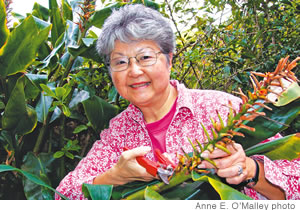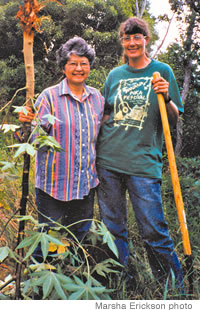Uprooting Aliens In Koke‘e State Park

Kay Koike with a kahili ginger head
Kay Koike’s efforts have led others to join her in rooting out alien species and allowing native plants to thrive
You could say the aliens got to her. In 1997, Kay Koike took up the battle cry against the castor beans growing along the roadside in Koke’e State Park and became the first volunteer in the Koke’e Resource Conservation Program (KRCP) when it started up the following year.
In fact, her hue and cry was integral to the inception of KRCP in 1998 under the nonprofit Hui O Laka up in Koke’e, and since 2006 has been under the Garden Island Resource Conservation and Development Inc. Its mission is to eradicate alien species that threaten the native plants of Kaua’i’s uplands.
The results?
As of October, 23,529 volunteers – including repeat volunteers – have spent 113,167 hours removing 8,960,671 invasive weeds covering 8,386 acres. They trounce the dickens out of strawberry guava, kahili ginger, Australian tree fern, Bush beard grass and more.
“I turn in my scores at the end of day,” says Koike. “I would have to say over the years it’s thousands of invasive species – that means many thousands fewer that grow in the forest, and that means that many more natives survive.”
Ask Koike how she measures success and she says it’s not just a physical count of how many weeds get pulled or plants get notched and squirted with herbicide.
“It’s the idea that when you come back and check the area again, you find the weeds haven’t grown back and that the native understory, like the ukiuki – a native lily – is coming back, those kinds of things,” she says. “And we can see little mokihana seedlings and koa seedlings coming up, because they were under all that.
“That is the most satisfying thing that, weed by weed, we can help the native forest. It doesn’t have to be a whole wide swath, it can be a little patch, and when I see natives coming up, that makes me feel good.”
Katie Cassel, who heads KRCP, was in on that first castor bean pull-out – it had roots 3 feet long. She agrees the program is important because the habitat needs protection for its endangered species to come back from the brink.

KRCP volunteers Kay Koike (left) and Katie Cassel uproot an alien castor bean plant
“Our forests represent some of the most diverse and botanically rich forests in the world,” says Cassel, pointing out that on Kaua’i alone, there are now more than 140 endangered plant species listed, 40 of them added just in the last couple of months. “Ensuring the continued existence of native dominance and regeneration of these native plant communities is crucial to preserving global biodiversity as well as preserving a cherished cultural resource,” Cassel adds.
Sponsors certainly get it. A number have jumped onboard, including Hawaii Community Foundation’s Cannon Fund and Annie Sinclair Knudsen Fund, The Nature Conservancy, Hawai’i Tourism Authority, Natural Resources Conservation Service, National Fish and Wildlife Foundation, U.S. Fish and Wildlife Service, Pioneer Hi-Bred International Inc. and Malie Inc.
More support comes from the Bay and Paul Foundation, John Plews, Marvin Lindmark, The Parker Group, Aqua Engineers, Crop Production Services, Kekaha Federal Credit Union, Kaua’i Landscape and Nursery, Mokihana Pest Control and many more local businesses.
Our youths get it, too. College students vie for internships, school groups flock to the forest for field trips to offer helping hands, and the Youth Conservation Corps – a hands-on summer learning experience aimed at educating Hawaii’s youths on the many conservation issues that threaten our state – joins in.
While Koike claims no credit for the evolution of the program, she’s a living example of Margaret Mead’s famous words, “Never doubt that a small group of thoughtful, committed citizens can change the world. Indeed, it is the only thing that ever has.”
She’s earned an award for her efforts – the annual One Person Can Make A Difference award issued by Koke’e Museum.
Kaua’i born and raised, Koike has a vested interest in the look, feel and health of her beloved Kokee.
“Koke’e has always been a part of me, my heart,” says Koike. “Literally speaking, it’s in my backyard because I live in Kekaha, and since I was a kid I’ve been coming up here for summer vacations, staying in a plantation cabin, coming on picnics and bringing visitors up here.”
Away from Kaua’i for more than three decades to work as a teacher abroad, Koike resumed her relationship with the uplands upon her return.
“I enjoy working with other volunteers and helping them to learn what the weeds are and how to distinguish them from the natives – especially when they’re in the seedling state,” she says. “It’s a case of beauty is the beast up here, because mostly every flowering plant easily seen – except the lehua blossom – is the beast.
“People coming up here see the purple flower of the Tibouchina and say, ‘Oh, look at the Tibouchina, the ginger, how beautiful they are.’ I used to feel the same way, but working with KRCP I have learned to let go of the beauty of the aliens and love the shy and modest natives.”
KRCP always needs volunteers, even on short notice, Monday through Thursday.
You must be logged in to post a comment.




There are no comments
Add yours